Basil leaves turning white is a signal that shouldn’t be ignored. With a proper diagnosis, you can determine the best course of action, be it adjusting the plant’s care routine or intervening with treatments. By adopting a preventative approach and remaining vigilant, you’ll ensure that your basil plants remain a lush, green cornerstone of your garden, ready to enhance your cooking and delight your senses.
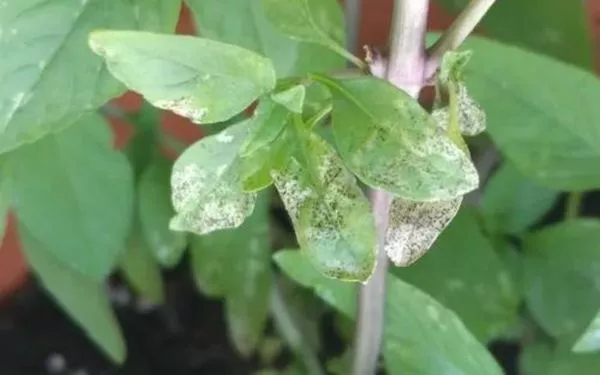
Table of Contents
Why are the basil leaves turning white?
Everybody wants a productive plant. Especially those that produce some kind of food or medicine. When a basil plant starts to discolor, the fruitification of this herb will be severely hindered.
Understanding why it is doing so will help you correct the problem so it can thrive again.
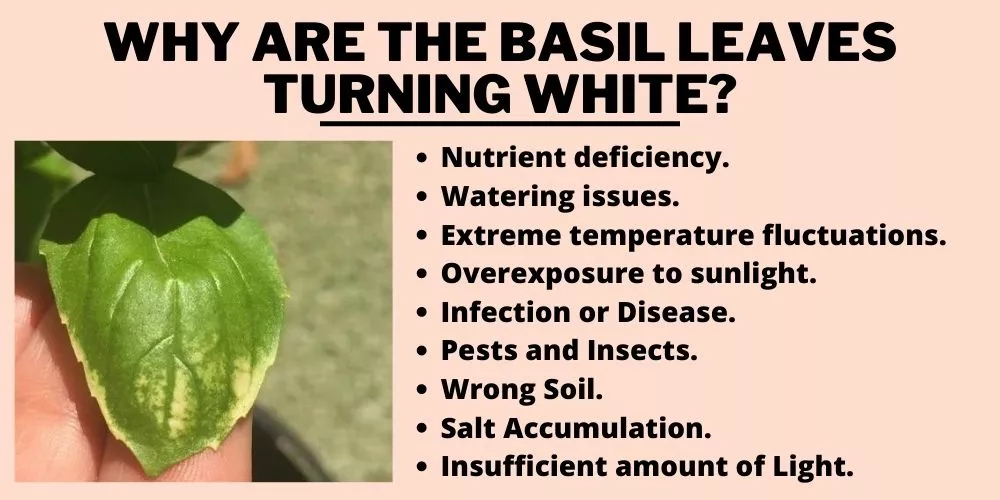
Unfortunately, there isn’t one easy method of healing your basil. Rather, there is a list of checks that you should make to eliminate the cause. Here are the most common reasons that a basil plant will turn white.
Nutrient deficiency
Basil plants don’t require anything out of the ordinary regarding nutrients. They thrive best with a balanced NPK (Nitrogen, Phosphorus & Potassium) mix. If one of these main 3 is lacking, you may see a pale white to yellow color forming on the plant.
The veins and leaves usually show more visible signs. They can be full color or even spots depending on the nutrient lacking. A lack of sulfur and iron can also uncover signs of discoloration.
Solution
It’s always advised that you use fertilizer when planting your basil. If you have purchased the plant already in a pot and don’t plan on repotting, you can add smaller doses of a water-soluble fertilizer every 2 weeks to your plant. The best time to do this is between spring and autumn.
Watering issues
Both overwatering and underwatering can cause problems for your basil plant.
Overwatering
This issue is coupled with poor drainage. Overwatering causes the roots to sit in a pool of water under and in the soil. The roots will rot, and the whole root system will become damaged. When this occurs, the roots won’t be able to soak up nutrients and water. The basil plant will turn white/pale yellow as it gasps for what it requires.
Underwatering
Poor hydration will weaken the root system and reduce the plant’s ability to reach for nutrients within the soil. This stops it from creating its energy to grow. The plant will dry out, and the leaves will turn pale white.
Solution
The best way to deal with overwatering is to report. You may try following things as well.
- Remove the plant from its existing container.
- Gently wash away all soil to reveal the roots.
- Carefully prune away any mushy/dead roots and/or leaves with a sterilized cutting tool.
- Repot using a well-draining container and soil mixed with a good quality NPK balanced fertilizer.
If you’re dealing with underwatering then you can try this.
Test the soil by sticking your finger an inch into the soil. If it’s bone dry, then give your basil a drink and aim to keep it moist without drowning it.
Extreme temperature fluctuations
Basil thrives best in the warm and doesn’t tolerate the cold too well. Anything lower than 50°F (10°C) can start causing some real issues regarding growth. The optimal growing temperature for a basil plant is between 68 to 80°F (20 to 27 °C).
If the temperatures swing too high or too low, too fast, the plant will go into shock. The shock will either distort its growth, cause wilting or discolor the plant to a pale white/yellowish hue.
Solution
Consider waiting until the season’s frost is gone before planting from seed. You can also give your basil a bit of protection by planting them somewhere with either a windbreak or partial shade, especially if your location suffers from the scorching midday sun.
Overexposure to sunlight
Basil loves the sun; it prefers full morning sun, though. Later in the day can pose some issues with the harsh sun’s heat and can cause leaf burn. Additionally, the plant becomes dehydrated and struggles to maintain energy to reach for nutrients and grow. This causes the leaves to turn white as a result.
Solution
The best preventive method is simply monitoring how much light the plant gets. Plant them somewhere that becomes shaded later in the day to offer that extra protection.
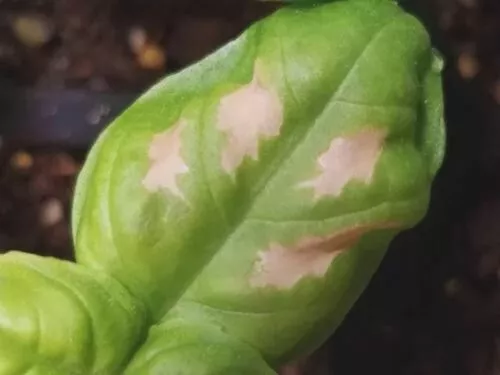
Infection or Disease
The 2 most common diseases a basil plant can suffer from are Downy Mildew and Fusarium Wilt. They both cause yellow/white leaves via chlorosis as the infections start to take hold of the plant. If left unattended, they will cause the plant to continue discoloring toward a browner color. After a while, they will wilt and die.
Solution
These are both pretty tough for a plant to overcome. Downy Mildew can be fended off via some store-bought fungicides. Fusarium Wilt is almost impossible to recover from. It’s best to remove the basil and dispose of it correctly. Additionally, you should disinfect the container to prevent further contamination.
Pests and Insects
The 3 most menacing pests that can wreak havoc on a basil plant include aphids, nematodes and white flies. Aphids and white flies attack the leaves by sucking out all the moisture. They leave the plant dehydrated and unable to obtain precious nutrients to help it grow stronger and defend itself.
Solution
Thankfully, aphids are large enough to pluck them off by hand. All 3 can be warded off using store-bought insecticides or even a homemade concoction. I use the following and have had great results:
Mix:
- 1 cup of vegetable oil.
- 1 tablespoon of mild liquid soap.
- Add 2-8 teaspoons of this mixture to 1 quart of water into a spray bottle.
- Spray on the affected plants.
Wrong Soil
Basil has 3 main requirements when it comes to soil choice. It must be able to drain well, have good air circulation, and oxygen available. The latter comes with adequate air circulation.
It also needs between 5.5-6.5 as a pH value. Anything outside that range can make some essential nutrients unavailable, which will stunt its growth as a result. Inadequate nutrients can also make the basil leaves turn white.
Solution
Keeping the soil healthy is the best advice you could receive. This can mean checking the pH periodically. You can plant with more organic soils, which assist with the uptake of nutrients. Adding fertilizer will also help balance out nutrients.
Salt Accumulation
Living in a location with excess air salt, poor quality water and/or over-fertilizing can cause a build-up of salt within your basil plant. Too much salt will dry the plant out and turn the leaves white.
Solution
The easiest way to correct salt accumulation is to ensure your containers have adequate drainage. This will allow the soil to be flushed of any excess salt. Another suggestion is to use better quality water.
Whether distilled, filtered or rainwater, these sources are generally much cleaner when compared to town water where chemicals are added. Lastly, take it easy with the fertilizer. Plants need the nutrients, but it’s a good idea to test the soil to ensure that they aren’t relieving more than they need.
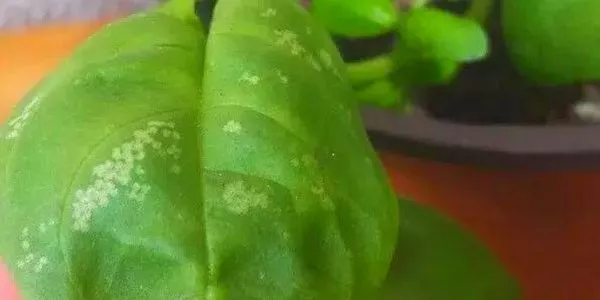
Insufficient amount of Light
Plants need light to produce chlorophyll; chlorophyll is required to produce food itself as an energy source. Basil plants need 6-8 hours of light to use this method. If they don’t receive enough, they will become more of a pale yellow/white color instead of turning that glowing green hue.
Solution
Plant your basil where it can receive 6-8 of direct sunlight daily. Whether that’s in the garden or even if their growing container can be moved around to suit the sun. If you are growing your basil under lights, aim to have them no closer than 6 to 12 inches from two 40-watt, cool white fluorescent grow bulbs for a minimum of 14 to 16 hours per day.
Treating White Basil Leaves: Effective Solutions
Once you have identified the likely cause of your basil’s discoloration, action must be taken. Against the harsh effects of the sun, relocating potted basil or providing some shade during the hottest parts of the day can mitigate the issue. For those in garden beds, consider temporary shading solutions like row covers or higher plants that provide partial shade.
Furthermore, address over-watering by letting the soil dry out slightly between waterings. Ensure the pot or bed allows for proper drainage and avoid letting the basil sit in standing water.
For fungal woes, removing affected leaves as soon as you notice them can slow the spread. In more severe cases, organic fungicides like neem oil may be necessary. Always follow the instructions carefully when applying any treatment.
Pest infestations require a vigilant approach. Often washing the leaves gently with a soap solution can dislodge mites and flies. In persistent cases, organic insecticidal soaps can be applied, targeting the pests directly while being safer for the plant and environment than harsher chemical options.
Prevention: Keeping Your Basil Healthy
Proper placement of the plant ensures it receives sunlight but is protected during the most intense midday rays. Checking the soil moisture before watering can keep your basil’s “feet” from being too wet.
Adopt a regular inspection routine to catch fungal issues and pests before they become major problems. And always quarantine new plants before introducing them to your garden to avoid the spread of pests or diseases.
Is it OK to eat basil leaves with white spots?
You can eat basil if it has white spots as long as a fungal or bacterial disease doesn’t cause them. Technically, you could, but it’s never a good idea to willingly consume any type of fungus and/or bacteria.
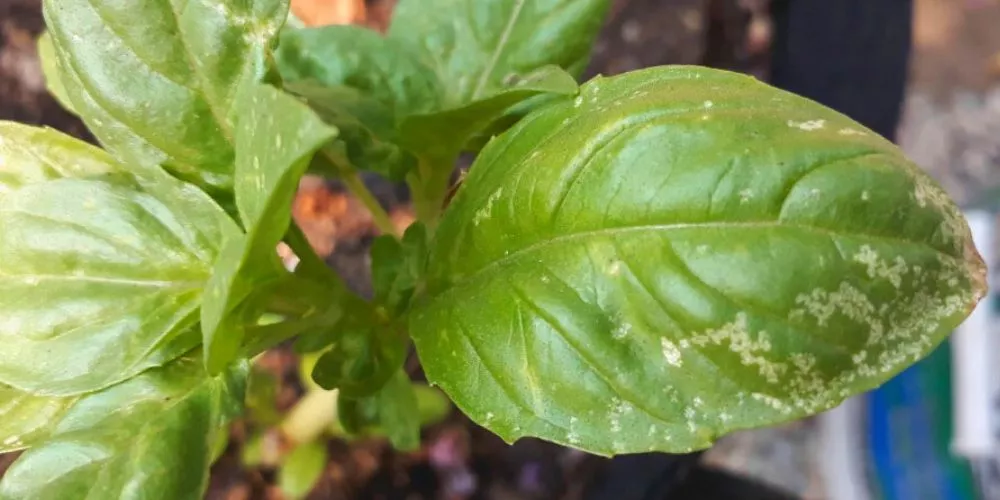
White-spotted leaves can be caused by various issues such as nutrient deficiency, over/underwatering, light/heat/temperature imbalances, poor soil, pest infestation, etc.
These problems won’t deem the basil plant inedible; they will make the herb taste much different than it should. The basil will generally taste rather bitter.
You may also find useful: 11 Basil Companion Plants | How To Harvest Basil Without Killing The Plant?
Frequently Asked Questions (fAQs)
How do you fix yellow leaves on basil?
3 main conditional issues can cause your basil leaves to turn yellow. These are nutrient deficiency, lack of sun and overwatering.
The problems can be corrected by using a balanced 10-10-10 fertilizer, re-locate your plant to somewhere that receives 6-8 hours of sunlight per day and reducing watering.
Sometimes overwatering may also require you to report a plant entirely. They can suffer from root rot and need a cleanup, new fertilizer, new soil, etc.
Why are my basil leaves turning silver?
Silver leaves on a basil plant can result from mold in the air or within the plant’s growing area. This can be brought on by poor air circulation and excess moisture in the air. You can deal with this by relocating the plant to somewhere with better airflow.
Additionally, you can use a copper-based fungicide to help rebalance the problem. As a last resort, try repotting with the focus on using soil that offers better air circulation at the roots. For example, fluffier, more organic soil mixes.
What does Overwatered basil look like?
In the early stages, you’ll notice the leaves wilt, turning yellow, and then brown. If left for too long, the roots will start rotting and smell moldy. This will eventually turn the whole plant brown, and it will die.
Conclusion:
There are many reasons why a basil plant’s leaves can turn white. These include nutrient deficiency, watering issues, extreme temperature fluctuations, too much sun, disease, pests, excess salt, wrong soil and poor light. Some of these issues are easy to correct, others not so.
As far as disease is concerned, it’s almost impossible to save your basil plant. We hope that we have been able to help you better understand how these issues occur and what you can do to fix them.


